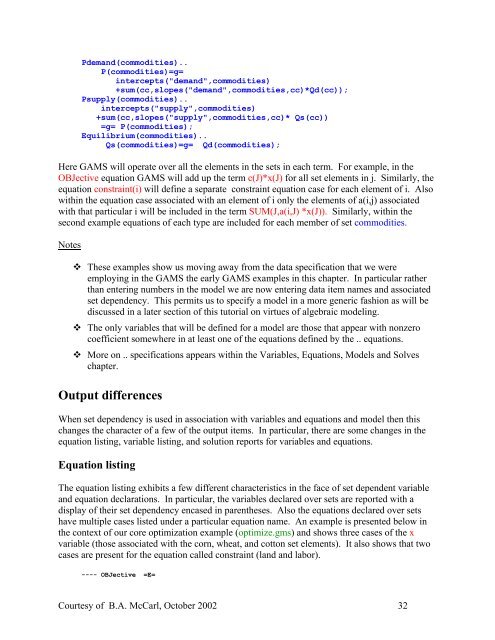Create successful ePaper yourself
Turn your PDF publications into a flip-book with our unique Google optimized e-Paper software.
Pdemand(commodities)..<br />
P(commodities)=g=<br />
intercepts("demand",commodities)<br />
+sum(cc,slopes("demand",commodities,cc)*Qd(cc));<br />
Psupply(commodities)..<br />
intercepts("supply",commodities)<br />
+sum(cc,slopes("supply",commodities,cc)* Qs(cc))<br />
=g= P(commodities);<br />
Equilibrium(commodities)..<br />
Qs(commodities)=g= Qd(commodities);<br />
Here GAMS will operate over all the elements in the sets in each term. For example, in the<br />
OBJective equation GAMS will add up the term c(J)*x(J) for all set elements in j. Similarly, the<br />
equation constraint(i) will define a separate constraint equation case for each element of i. Also<br />
within the equation case associated with an element of i only the elements of a(i,j) associated<br />
with that particular i will be included in the term SUM(J,a(i,J) *x(J)). Similarly, within the<br />
second example equations of each type are included for each member of set commodities.<br />
Notes<br />
These examples show us moving away from the data specification that we were<br />
employing in the GAMS the early GAMS examples in this chapter. In particular rather<br />
than entering numbers in the model we are now entering data item names and associated<br />
set dependency. This permits us to specify a model in a more generic fashion as will be<br />
discussed in a later section of this tutorial on virtues of algebraic modeling.<br />
The only variables that will be defined for a model are those that appear with nonzero<br />
coefficient somewhere in at least one of the equations defined by the .. equations.<br />
More on .. specifications appears within the Variables, Equations, Models and Solves<br />
chapter.<br />
Output differences<br />
When set dependency is used in association with variables and equations and model then this<br />
changes the character of a few of the output items. In particular, there are some changes in the<br />
equation listing, variable listing, and solution reports for variables and equations.<br />
Equation listing<br />
The equation listing exhibits a few different characteristics in the face of set dependent variable<br />
and equation declarations. In particular, the variables declared over sets are reported with a<br />
display of their set dependency encased in parentheses. Also the equations declared over sets<br />
have multiple cases listed under a particular equation name. An example is presented below in<br />
the context of our core optimization example (optimize.gms) and shows three cases of the x<br />
variable (those associated with the corn, wheat, and cotton set elements). It also shows that two<br />
cases are present for the equation called constraint (land and labor).<br />
---- OBJective =E=<br />
Courtesy of B.A. McCarl, October 2002 32
















